 Kedarnath is a town and nagar panchayat nestled in Rudraprayag district in the Uttarakhand state of India. It is mainly known for the ancient Kedarnath Temple. The surrounding picturesque views of the town are a treat to the eyes, even though it is built on a barren stretch of land on the shores of Mandakini River. It offers amazing scenic views of Himalayan Mountains to its arrivals. Then behind the town and Kedarnath temple there stands the majestic heights of Kedarnath peak, Kedar Dome and other peaks of the range. Everything together makes it an attractive tourist destination. In June 2013, the town suffered extensive destruction from flash floods caused by torrential rains in Uttarakhand.
Kedarnath is a town and nagar panchayat nestled in Rudraprayag district in the Uttarakhand state of India. It is mainly known for the ancient Kedarnath Temple. The surrounding picturesque views of the town are a treat to the eyes, even though it is built on a barren stretch of land on the shores of Mandakini River. It offers amazing scenic views of Himalayan Mountains to its arrivals. Then behind the town and Kedarnath temple there stands the majestic heights of Kedarnath peak, Kedar Dome and other peaks of the range. Everything together makes it an attractive tourist destination. In June 2013, the town suffered extensive destruction from flash floods caused by torrential rains in Uttarakhand.
Etymology of Kedarnath
The town is named after King Kedar, who ruled in the Satya Yuga. He had a daughter named Vrinda who was a partial incarnation of Goddess Lakshmi. The land is named after her as Vrindavan.
Location of Kedarnath
It is located in a beautiful valley in the Himalayas, about 3,583 m above sea level near Chorabari Glacier, the head of river Mandakini. It is situated at a distance of 223 kilometer from Rishikesh in Uttarakhand. The nearest road head is at Gaurikund, at a distance of 14 kilometer.
Demography of Kedarnath
According to the India census report of 2001, the town had a population of 479 of which males constitute 98% and females 2%. In the town, none of the population is under 6 years of age. The floating population from May to October every year is more than 5000 per day. On the basis of the report of same year, the town had an average literacy rate of 63%. The male literacy was 63% and female literacy was 36%.
Mythological Significance of Kedarnath
It is said that Kedarnath exists since Mahabharata era. According to local belief, the temple was built by Pandavas to please Lord Shiva by doing penance there. It is one of the significant dhams amongst the Chota Char Dham.
Attractions of Kedarnath
The town is immensely popular for the Kedarnath temple. It is one of the holiest Hindu temples dedicated to Lord Shiva. Here Lord Shiva is worshiped as Kedarnath. It is nestled near the Mandakini River. Every year, Pilgrims from various distant places visit this ancient holy site.
Bhairava temple, on the eastern side of the town, is another attraction. Bhairava, the deity of the temple, is believed to protect the town during winter months. Chorabari Tal, a lake cum glacier is also popular amongst the tourists. Also called Gandhi Sarovar, it is situated around 6 kilometers away from the town.
Near Kedarnath, there is a cliff called Bhairav Jhamp. This is the point from where devotees used to jump to death to get instant salvation. This practice was banned by British Government in the 19th century.
Connectivity to Kedarnath
The town can be reached by trekking on a paved bridle path. One can also hire horse or palanquin services from Gaurikund. Gaurikund is linked by road from Rishikesh, Haridwar, Dehradun, Garhwal and Kumaon regions in Uttarakhand. The alternative option is helicopter. The air service can be availed from Dehradun.



















